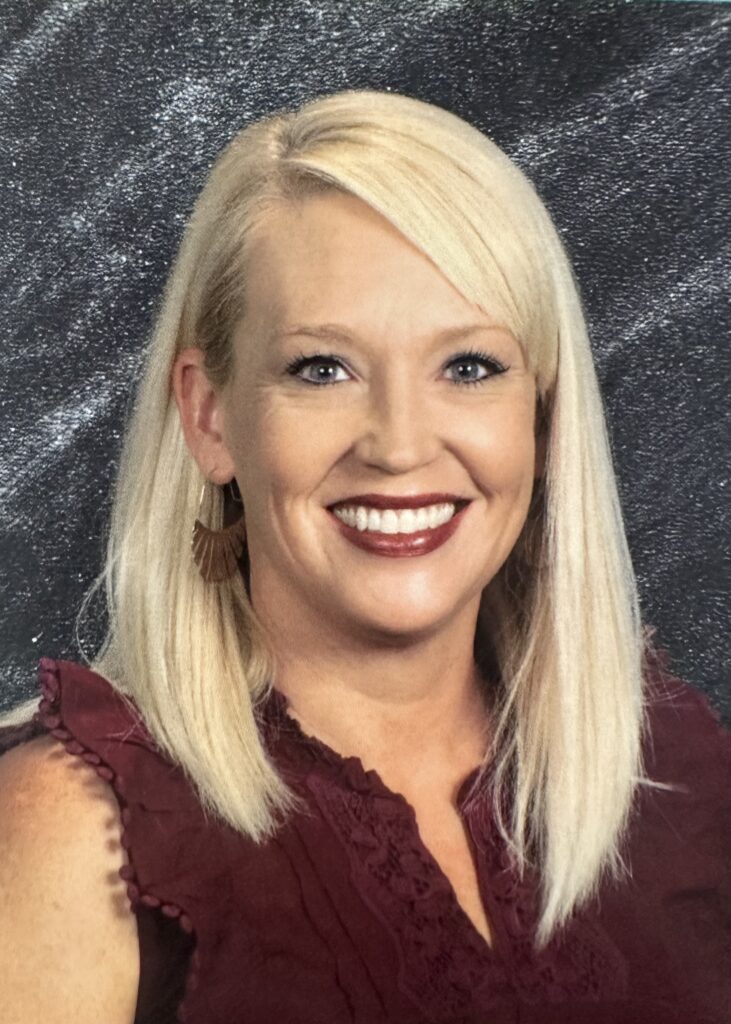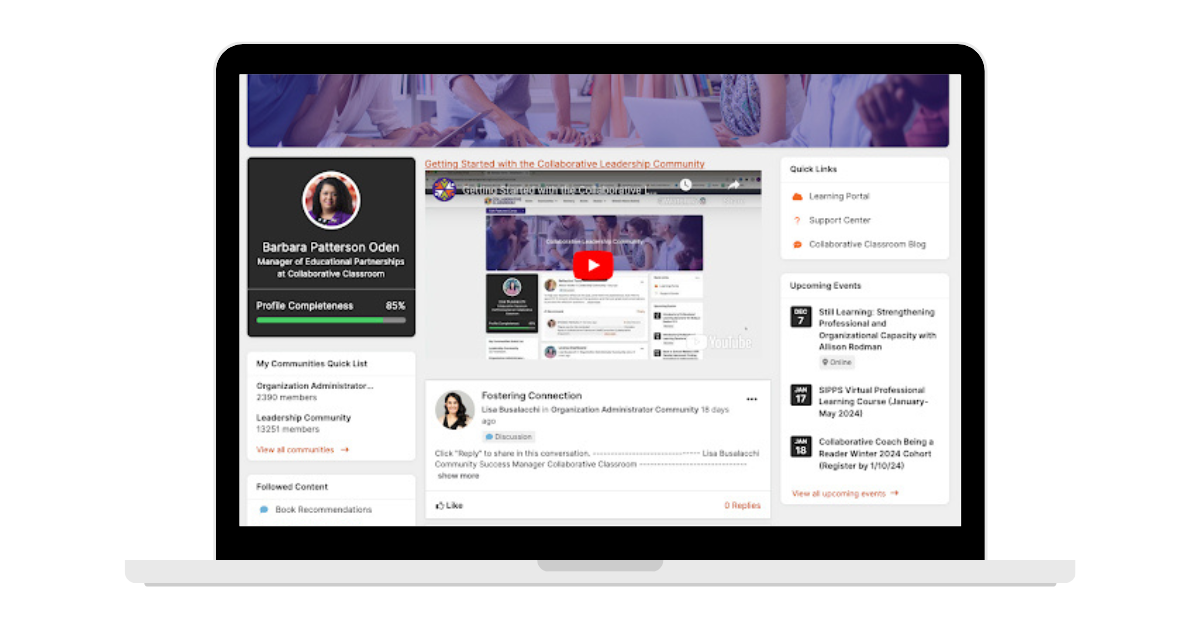
Amy Oliver is a part-time reading intervention teacher (TOSA) at Hollingworth Elementary School in Rowland Unified School District, where she oversees the school-wide reading intervention program, Everyone Reads!
Through the Collaborative Leadership Community, Amy connects with fellow educators to share strategies, navigate challenges, and strengthen her school’s implementation of SIPPS.
Tell us a little about yourself, your school and district, and the students that you serve.
My name is Amy Oliver, and I am currently a part-time reading intervention teacher (TOSA) at Hollingworth Elementary School in Rowland Unified School District.
I come from a family of educators, and everyone always told me I would become a teacher one day too. I guess I had to come to that conclusion on my own—when I attended UCLA for undergrad I earned my BA in Communications Studies.
After a few years working as a reporter for a local newspaper, I realized I wished I was on the other side of the pen when interviewing teachers for education stories. So I went back to school to earn my multiple subject teaching credential and Master’s of Education from the University of La Verne.
I spent my first eight years teaching first grade, which really solidified the passion I always had for literacy and underscored the importance of early childhood education. I also taught fifth grade for one year.
Eventually, I moved on to a district position as ELA Program Specialist. In this role, I oversaw ELA curriculum, instruction, professional development, and was an instructional coach at various schools in the district.
After having two children, I was looking for a better home/work-life balance, so two years ago I moved into my current part-time position. In this role, I oversee our school-wide reading intervention program, which we call Everyone Reads!

This year we have 15 tutors who use SIPPS four days a week for 30 minutes each day to support any students identified as At Risk in grades K–6. The 2024–25 school year is our third year implementing this program using SIPPS.
Hollingworth Elementary is a small school in West Covina, CA, with only two classes per grade and sometimes only 1.5 in the upper grades. However, we have a large staff because in addition to the 13 TK–grade 6 classes we have four Extensive Needs classes and nine Special Ed preschool classes. This means we have a lot of support staff on campus including instructional aides, speech and language pathologists, occupational therapists, PE teachers, music teachers, counselors, and a behavior support assistant.
Although we don’t have a large number of students, their emotional, behavioral, and academic needs are great. We are a Title I school, as is our district. We have many second language learners who speak a diverse number of languages.
What do you love about being an educator? What do you appreciate most about being in your current role?
First and foremost, I think I love learning myself, and I have always enjoyed helping others learn as well. I love to see that spark of curiosity and interest in my students, their excitement when they are passionate about what they are learning, and the look of pride when they accomplish something challenging.
I also really love working with people, students and adults alike, and especially enjoy collaborating. There are three things I appreciate about my current role: First, the wonderful people and students I get to work with; secondly, that I can focus on one thing I am passionate about—helping struggling students learn to read; and lastly, but perhaps most importantly, the autonomy and flexibility I have in this part-time position because it allows me to focus on my family more.
What first brought Rowland Unified Schools to Collaborative Classroom? What Collaborative Classroom programs are you currently implementing? Tell us about that work.
In Rowland Unified we have many elementary schools that use SIPPS for reading intervention, and there may even be some schools that use other Collaborative Classroom programs as well.
I know some schools that have been using SIPPS for traditional reading intervention for almost 10 years, while others, like my school, just started to use SIPPS recently. I think more of our schools started to use SIPPS after we came back from distance learning because we saw an increase in the number of students in all grades who were struggling with foundational skills, and thanks to Covid relief/ELO funds, schools were able to purchase support programs and staff.
So we are all on a different part of our SIPPS journey, and I think we all use it a bit differently at each school site as well. Some schools have one reading intervention teacher who pulls small groups of at-risk students out of class throughout the day, 3–4 times a week, to teach SIPPS lessons.
Other schools have hired a small team of people—aides, TOSAs, and impact teachers—to work with small groups of students using SIPPS. In this model, each grade level has a designated time for SIPPS; for example, at 8:30 a.m. they work with first grade, then at 9:15 they work with second grade and so on. The classroom teachers in each grade have a group of students as well, and sometimes they use other programs for students who don’t need foundational skills support.
My school’s model is a bit unique because we have a large number of instructional aides for preschool who start work at 7:30 a.m. but the preschool students don’t arrive until 9:00. So they are able to teach a SIPPS group in the hour before preschool begins. We also have some preschool teachers, ed specialists, and speech/language pathologists who teach SIPPS groups.
At the beginning of the year we assess all our students in grades 1–6 using the SIPPS placement tests, and then I create groups based on the number of tutors we have each year. Each group meets four days a week for 30 minutes a day, from 8:15 to 8:45 a.m. Students who do not need SIPPS stay with their classroom teachers to work on grade level foundational or reading skills.
You serve as an intervention teacher and are an active member of the Organization Administrator Community. What do you find most helpful with the Collaborative Leadership Community (CLC)? Why is this worth your time?
There are a few things I find most helpful about the Collaborative Leadership Community. Firstly, it’s a great place to find information and resources, like the Upcoming Events and Quick Links sections. I also get new ideas from the video tutorials and discussion posts.
The CLC is also a supportive place to commiserate with each other over frustrations as well as celebrate our successes. Being a classroom teacher can be such an isolating job because you are alone with the students all day, but at least you can see your team members at recess, lunch, and after school. I am the only person at my school site in this role, and that can be challenging. The CLC helps with that.

When I started this position my principal and I were trying to figure out what the reading intervention program would be like at our school. I met with the other people in my district in similar roles so that I could ask them all about their reading intervention program and the curriculum they use. This way we didn’t have to reinvent the wheel, and I learned so much from hearing about their failures, successes, tips, and advice.
I continue to reach out to them if I have questions and try to get us together a few times a year. I think it’s part of my nature to want to collaborate. If something went well or horribly wrong in my class I would share it with my team at lunch, so they could try it out too, or avoid my mistakes. I am a firm believer that two heads are better than one and we can go so much further by working together and learning from each other.
I am a firm believer that two heads are better than one and we can go so much further by working together and learning from each other.
CLC is a great place to get answers to my many questions. I’m the type of person who will ask the question in a meeting that everyone else was thinking but no one would say out loud. I think some people feel embarrassed to ask for help, or admit it if they don’t know something. Fortunately, I think in an online setting like the CLC, more people feel more comfortable asking questions than they would in person. Even if no one knows the answer, you can start to figure it out together, or at least commiserate knowing you’re not the only one wondering something.
What specific benefits have you observed from interacting with the online community? If you have other colleagues in leadership who are members of the CLC, what do they appreciate about it?
Firstly, there is an element of emotional support and camaraderie when hearing from other people on the CLC discussion boards who are engaged in the same work as me. But more practically, I have benefited from the online community by getting questions answered and learning about resources and materials that I didn’t know about previously.
I have benefited from the online community by getting questions answered and learning about resources and materials that I didn’t know about previously.
For example, most recently I learned from a discussion post by Allison Voeller about the decodable book collections that can be used to support students in Beginning and Extension Levels of SIPPS. She also shared a document that tells teachers which of the decodable texts should be given to students to read after which SIPPS lessons to help support their fluency.
Another member of the CLC asked a follow up question about whether there were such decodable texts available for older readers, and Allison responded by sharing about the Hi/Lo Fluency Practice Collection. I was then able to ask another follow up question because I was wondering if there was a similar guidance document for the Hi/Lo Fluency Practice Collection that lists which texts correlate to which SIPPS Plus lessons. Such a document does not exist, but Allison shared some other helpful resources with me.
How do you engage in the CLC? (EG: Digest emails; logging in daily or once a week for updates, office hours, etc.?)
I usually skim the digest emails to see if there is something I am interested in or that pertains to the work I do. If there is, then I will read the post more carefully or log into the CLC to be able to clearly follow the discussion thread.
I should make it a point to log into the CLC at least once a week because there are helpful reminders and tips on the homepage. I will also sometimes save a digest email to go back to at a later time.
When I have pressing questions I will ask them on the Learning Portal live chat or email tech support. They are great about getting back to me quickly.
Lisa Busalacchi, Digital Learning Manager, and her team were very patient with me, and explained the origin and purpose/mission of Collaborative Classroom and how they prioritize research in order to create the best curriculum possible. They were always very accommodating and willing to schedule a time to talk to me on the phone or Zoom as needed, and have since added so many more ways to support those of us implementing their curriculum.
The introduction of office hours was something I was really excited about. I have attended office hours and I scheduled a one-on-one time with Lisa at the beginning of the year to ask a few specific questions. I try to keep a running list of questions, comments, or suggestions I have that I bring up during office hours or whenever I have a Zoom with Lisa.

Let’s talk a bit about surrounding educators with supportive systems. What do you need as a leader to support the educators in your organization through implementation? How has the CLC supported you to achieve these goals?
I think the most important thing I need to be able to support my teachers’ implementation is the ability to contact someone from Collaborative Classroom with more experience and knowledge than me when I have a question I am not able to answer or a dilemma I am unable to solve.
This includes technical questions about the Learning Portal, content questions about where to find specific materials or information in the curriculum, and instructional questions about how best to teach lessons, analyze data, or group students.
It’s nice that we have the chance to ask these questions on the discussion forum on the CLC or in office hours so others can hear and benefit. Additionally, I have really appreciated the lesson videos that have been added to the Learning Portal in the last year or so because watching someone else teach a lesson in real time is so helpful.
I have really appreciated the lesson videos that have been added to the Learning Portal in the last year or so because watching someone else teach a lesson in real time is so helpful.
Because of the unique situation at my school and everyone’s schedules being so different, I don’t have many opportunities to meet with, train, or model lessons for my SIPPS tutors, but they are able to watch the videos when it’s convenient for them.
I also appreciate that most all SIPPS resources are physical and digital, because my tutors vary in their comfort level with technology. Even those who prefer to use the physical manuals appreciate being able to scan the QR codes to view videos or animations.
At Collaborative Classroom we’re always eager to learn from our school and district partners. What is something you hope to get from the CLC in the future? Do you have any ideas on how we can continue to grow the community?
I hope to be able to attend more office hours and professional development offered by Collaborative Classroom in the future. I just happen to be at a point in my life where I have to be very selective about how I spend my time—since I work part time I have to prioritize what needs to get done in the limited time I have. There are so many things available on the CLC that interest me but I just am not able to engage in right now.
I do appreciate that the CLC discussion posts, resources, and staff are there for me when I need them, and I hope to engage more, in a less selfish way, as time goes on. One idea to grow the community might be to partner new leaders who are joining the CLC with a more experienced member for their first year. This person would be their point of contact or someone to check in with monthly to see how things are going—sort of like a master teacher/new teacher relationship.
There could be guiding questions or topics to discuss throughout the year, but also just having open time to collaborate and ask questions would be nice. Or cohorts/groups of leaders from the same district or in similar situations could be formed and they could meet virtually once a quarter to collaborate and discuss specific topics.
Related:
Read another blog: How the Collaborative Leadership Community Helps Lake Mills Area SD Thrive
Learn More About the CLC
Take a closer look at how the Collaborative Leadership Community platform works.
